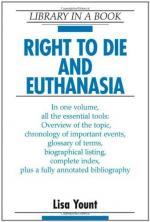|
This section contains 3,819 words (approx. 13 pages at 300 words per page) |

|
ALTHOUGH A FEW people like Jack Kevorkian may assist a terminally ill person's suicide or even commit euthanasia regardless of what the law says, most hesitate to perform actions that are illegal. A country's legislatures and courts therefore have a huge effect on what people do to control their own or others' deaths. Laws and court rulings made since the 1970s have played a major part in defining the "right" to die.
In the United States, courts so far have proved more willing to tackle this touchy subject than legislatures. In some two hundred rulings starting with the famous Karen Quinlan case in 1976, "the judiciary has transformed not only the practice of medicine and the rights of patients, but has also shaped societal values," Lawrence O. Gostin writes in the Journal of the American Medical Association.
The right to refuse treatment
|
This section contains 3,819 words (approx. 13 pages at 300 words per page) |

|




